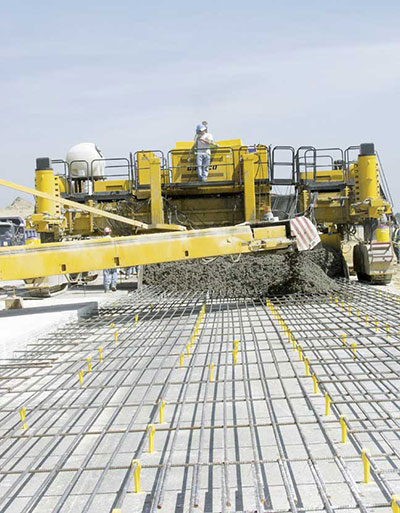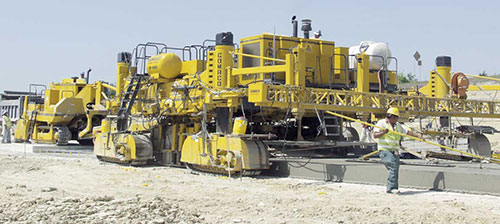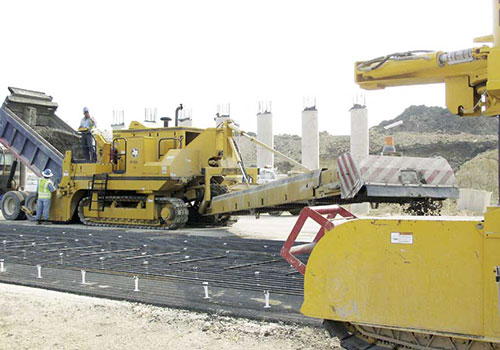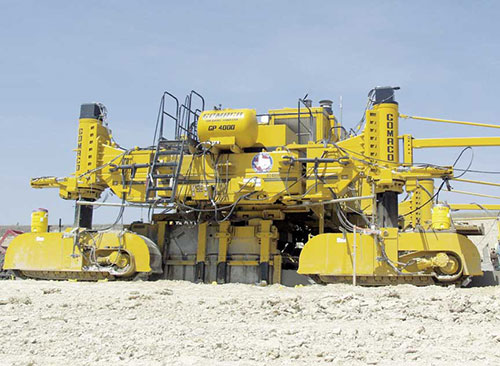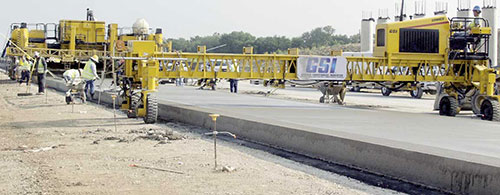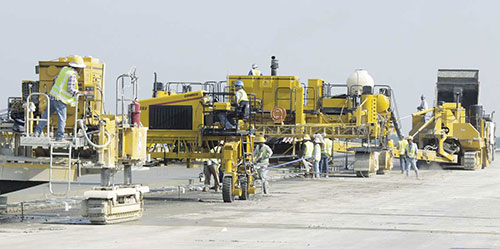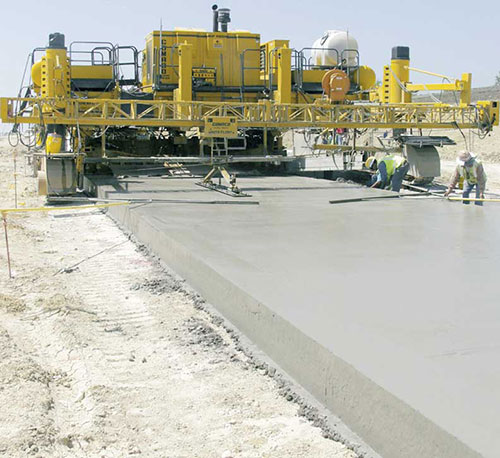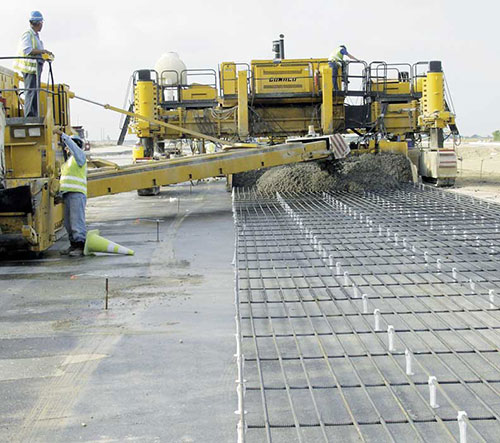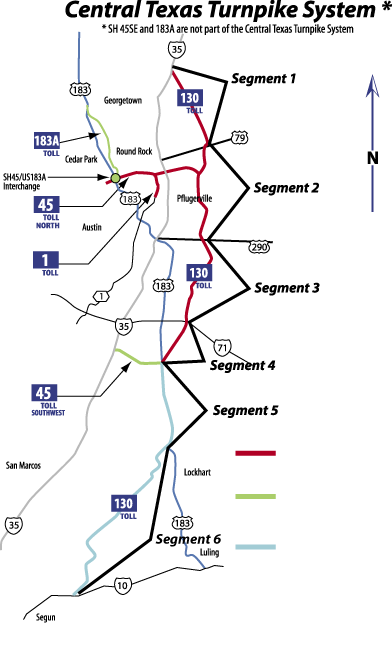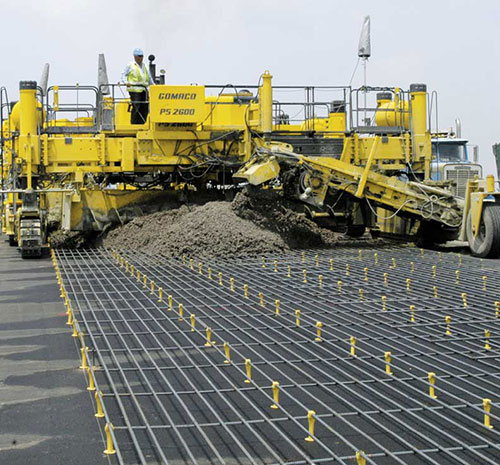GOMACO World Index --- GOMACO World 33.2 - September 2005
Paving 100 miles (161 km) of Concrete Toll Road in Texas
One of the largest construction projects in the United States is currently underway just outside of Austin, Texas. SH-130 is the largest single highway project the Texas Department of Transportation (TxDOT) has ever built. It includes 49 miles (79 km) of new concrete tollway that will stretch from Interstate 35 north of Georgetown southward to US 183 southeast of Austin, passing through the counties of Williamson and Travis.
The project is not only unique because of its vast size and price tag of over $1 billion, but also the manner in which it’s being built. It’s TxDOT’s first “Comprehensive Development Agreement” (CDA), which is similar to a design-build project. With a CDA, the selected consortium is responsible for acquiring right of way, designing, constructing, maintaining and partially financing the project.
The consortium winning the project bid is called Lone Star Infrastructure (LSI) and is made up of three main partners: Fluor Enterprises, Inc., Balfour Beatty Construction and T.J. Lambrecht. They are on a five-year time table with a project completion date of December 2007.
The figures involved with the project are staggering: 40 million yd3 (30,582,194 m3) of dirt and 2.5 million tons of concrete. It also includes the construction of 122 bridge structures consisting of 350,000 ft2# (32,515 m2) of steel and five million ft2 (464,515 m2) of concrete. There will be four main toll plazas constructed with 30 exit/entrance ramp toll plazas along the length of the project.
The concrete pavement itself consists of almost 100 miles (161 km) of roadway ranging from 40 to 64 feet (12.2 to 19.5 m) wide of which the majority will be 13 inches (330 mm) thick and paved over continuous steel reinforcing.
According to LSI, 95 percent of the SH 130 project is virgin right of way. However, the most unique aspect of the project is just the sheer size of it – 100 miles (161 km) of concrete paving that must be accomplished in a relatively short time frame.
TxDOT has also implemented the International Ride Index (IRI) to measure the smoothness of their new roadways. LSI needed a paver for the project that would meet the demands of the IRI while being durable enough to pave the entire project.
According to LSI, after devoting a great deal of time comparing various products to the necessary ride aspects of the SH 130 project, the GP-4000 was selected. Most notably, the GP-4000 was chosen because of the overall weight of the four-track machine and its ability to produce the best ride quality for life of the project.
LSI has two 12 yd3 (9.2 m3) central mix batch plants set up on site supplying concrete for both the new roadway and other concrete structures on the project. They’re utilizing 15 to 20 dump trucks to carry 9.5 yd3 (7.3 m3) loads of concrete to the paving site.
Since the majority of the project is being built on a grade with continuous steel reinforcing, the consortium also purchased a GOMACO 9500 placer. The trucks dump into the 9500 placer which sits along the haul road, off to the side of grade, and places the concrete over the steel.
The GP-4000 paver follows the placer paving at three different widths: 18, 22 or 24 feet (5.5, 6.7 or 7.3 m). The concrete mix design is a TxDOT standard 5.5 sack mix with an average slump of 1.5 to two inches (38 to 51 mm).
LSI is using 30 percent fly ash replacement for cement and adding retarder and air entrainment to help keep the concrete pliable. In addition, the consortium has a 95 degree F (35 degree C) maximum temperature specification so, as the temperatures increase this summer, they will add chilled water to the mix to keep it within the temperature spec.
The GP-4000 paver is equipped with an Auto-Float® to help finish and seal the surface of the slab. A GOMACO Smoothness Indicator® (GSI) is following behind the paver constantly monitoring the concrete slab while it’s still in a workable state. The consortium is using the GSI to monitor all aspects of their paving operation to ensure no steps are unintentionally hurting their ride quality.
LSI has had great success in using the GSI. They have used it over finished pavement, directly behind the paver in front of the finishers, behind the finishers and behind the texture/ cure machine. All aspects of the paving and finishing effort have been analyzed to ensure overall positive results.
TxDOT’s IRI specifications require an index reading of 65 to 75 for 100 percent pay. Anything from 75 to 95 carries a penalty and anything over 95 is considered a must grind or repair. Anything below a 65 is considered bonus pavement.
The 9500 places concrete over the continuous steel reinforcing in front of the GP-4000 four-track paver.
According to LSI, they have been successful at maintaining the mid to low 60s on the IRI.
LSI pays close attention to all the paving points, keeping a continuous head in front of the paver, training the crew properly, maintaining the paving plant itself, eliminating as many headers as possible and looking for long continuous runs. There is a lot of attention paid to check points that the paving crew must implement to ensure that the results are acceptable
A GOMACO T/C-600 texture/cure machine follows the GSI applying an astroturf drag finish, transverse tine and spray cure finish.
Average production per day is dependent on the concrete plants and the amount of concrete they’re capable of producing. LSI tries to maintain an average of 2500 to 3000 yd2 (2090 to 2508 m2) of concrete paving per day.
LSI points out that the most challenging aspect of the project is the sheer size of it and the coordination involved in every aspect. Some of those aspects include an in-house environmental firm to make sure nothing is done to pollute the area or harm the wildlife. They have a public information and outreach firm to deal with public relations. Design teams, engineering firms, consulting firms, right of way teams, utility relocation teams and bridge builders are at work on each section of the project. LSI is also in charge of their own quality assurance and quality control on the project and have a team that continually monitors their progress and reports their findings to both LSI and TxDOT.
LSI is on track to complete the project by the December 2007 deadline with the GP-4000 paving the nearly 100 miles (161 km) of new toll road.
Editor’s Note: Special thanks to Lone Star Infrastructure for letting us visit their job site and for all the time they gave us while we were there. Also, thank you to Bennett Closner and David Zuehlke with Closner Equipment Company, our GOMACO distributor in Austin, for helping coordinate the visit. Your help was greatly appreciated.
TxDOT’s IRI specs require a reading of 65 to 75 for full pay, anything under that earns bonus. LSI is averaging in the mid to low 60s.
Subscribe to Receive GOMACO World Magazine
